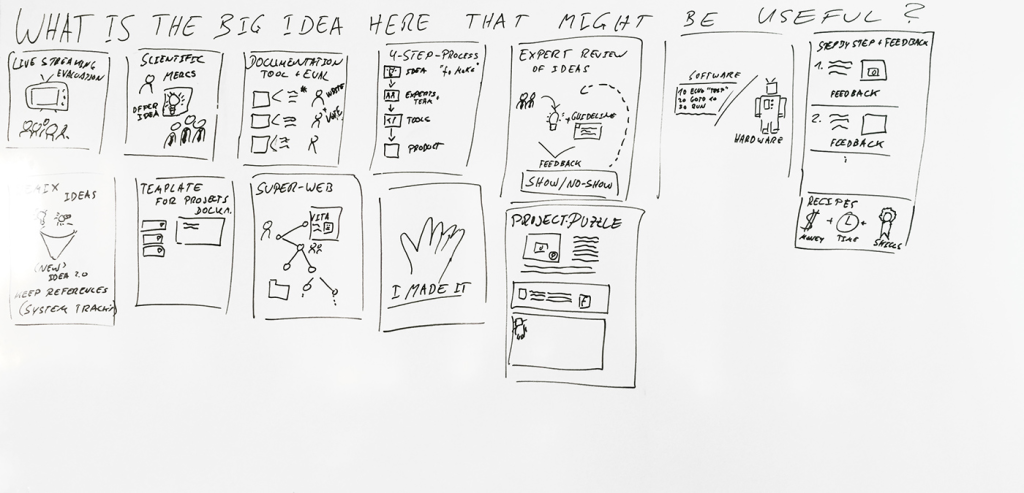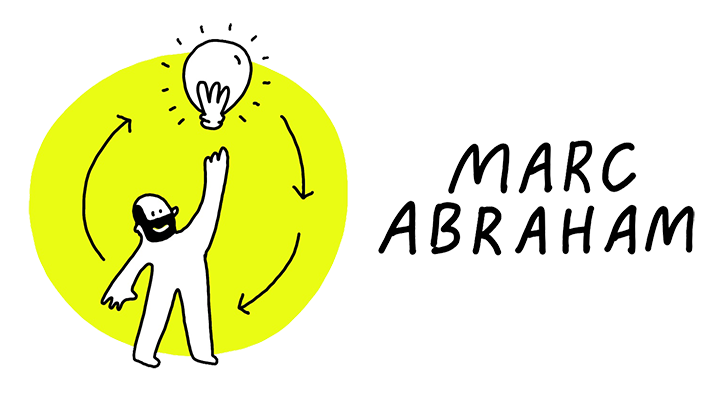Once you’ve set a target as part of Day 1 of your sprint, the next step is for you and your team to look at solutions. On the second day of the sprint, you’ll be coming up with solutions, and sketching them. This day consists of two key activities: (1) review ideas to remix and improve, and (2) create solution sketches to feed into your plan for a prototype and customer testing.
Remix and Improve
In “Sprint”, Jake Knapp, John Zeratsky and Brad Kowitz suggest a good technique to collate and assess ideas: Lightning Demos. With this exercise, your team will take three-minute tours of their favourite ideas or products: from other products, from different domains, and from within your own company. The idea here is to encourage the team to throw everything in the mix, but to do so in a short and snappy way. Each person who has suggested an idea will do a three minute demo, showing the team what’s great about his or her solution. As a facilitator, you might want to use a timer to make sure each team member sticks to the their three minute time slot.
The key thing with these three minute ‘lightning demos’ is that you capture the big ideas from each presentation. Start by asking the person who’s doing the tour, “What’s the big idea here that might be useful?” You can then make a quick drawing of this big idea, write a simple headline above it and add the source underneath. I’ve included an example of a way to capture big ideas in Fig. 1 below.
Fig. 1 – An example of capturing ‘big ideas’ from lightning demos

Sketch
In the afternoon of the second day of your sprint, the focus is on coming up with solutions. Instead of doing collective brainstorming sessions – which in my experience run the risk of becoming shouting matches or can be dominated by very vocal people – Knapp, Zeratsky and Kowitz suggest each team member coming up with ideas on their own. People will work individually, thinking about and sketching solutions. I’ve included a simple example of a sketch in Fig. 2 below.
The sketches that people create will act as an important driver for the rest of the sprint. On Wednesday (Day 3), you’ll critique everyone’s sketches and pick the best ones.
If you’re worried about the quality of your sketches, don’t! Knapp, Zeratsky and Kowitz introduce the four step sketch technique. This approach makes it easy for everyone to take some rough solutions and turn them into a detailed solution sketch (see Fig. 2 below):
- Notes – As a first step, the team walks around the room and takes notes from looking at all the post-it notes, whiteboards, flip-charts that you have collated over the first day and a half of your sprint.
- Ideas – Each team member individually will look at his or her notes and jot down rough ideas, simply filling a sheet with doodles, headlines, etc. The aim here is not to come up with fully fledged ideas or solutions. It’s purely a way for each person to drop down their thoughts.
- Crazy 8s – Crazy 8s is a fast-paced exercise. Each person will take his or her strongest ideas and rapidly sketches eight variations in eight minutes. What I like about Crazy 8s is that it stops you from dwelling on your first possible solution for too long. Instead, the eight minute deadlines forces you to quickly decide whether to move on from your first reasonable solution or to stick with it but iterate (see Fig. 3 and 4 below). I’ve found Crazy 8s to work particularly well if you end up sketching several variations of the same idea, exploring alternative versions. Similarly, you can use Crazy 8s to refine a marketing headline or messaging.
- Solution sketch – The solution sketch is each person’s best idea, put down on paper in detail. Up to this point, each team member will have worked individually on creating notes, ideas and Crazy 8s, and won’t have shared anything with the rest of the team. This all changes with the solution sketch; each solution sketch is an opinionated hypothesis for how to solve the challenge at hand. These sketches will be looked at – and judged – by the rest of the team. They will therefore need to be detailed, thought-out, and easy to understand (see Fig. 5 and 6 below).
Once each team member has put together a solution sketch, the sprint facilitator will collate them all and put them in a pile. The team will only be allowed to start looking at these solution sketches on the third day of the sprint.
Fig. 2 – Four step sketch technique

Fig. 3 – How to do Crazy 8s – Taken from: “Sprint”, pp. 112-113:
- Each person begins Crazy 8s with a single sheet of letter-size paper.
- Fold the paper in half three times, so you have eight panels.
- Set a timer to sixty seconds.
- Hit “start” and begin sketching – you have sixty seconds per section, for a total of eight minutes to create eight miniature sketches.
- Go fast and be messy: As with the notes and ideas, Crazy 8s will not be shared with the team.
Fig. 4 – Crazy 8s example

Fig. 5 – Important rules to keep in mind when creating a solution sketch – Taken from: “Sprint”, pp. 114-118:
- Make it self-explanatory – Your solution sketch needs to explain itself. Think of this sketch as the first test for your idea. If no one can understand it in sketch form, it’s not likely to do any better when it’s polished.
- Keep it anonymous – Don’t put your name on your sketch, and be sure that everyone uses the same paper and the same black pens.
- Ugly is okay – Your sketch does not have to be fancy (boxes, stick figures, and words are fine), but it does have to be detailed, thoughtful, and complete.
- Words matter – Strong writing is especially necessary for software and marketing, where words often make up most of the screen. So pay extra close attention to the writing in your sketch. Don’t use “lorem ipsum” or draw those squiggly lines that mean “text will go here.” That text will go a long way to explain your idea – so make it good and make it real!
- Give it a catchy title – Since your name won’t be on your sketch, give it a title. Later, these titles will help you keep track of the different solutions as you’re reviewing and choosing. They’re also a way to draw attention to the big idea in your solution sketch (see the example in Fig 6 below).
Fig. 6 – A solution sketch from Blue Bottle Coffee’s sprint; each sticky note represents one screen

Main learning point: The second day of the sprint is very solution oriented. Instead of long brainstorm sessions, the day is filled with more individually oriented activities, encouraging team members to think about ideas and to come up with their own solution sketch.
Related links:
- https://www.fastcodesign.com/3057076/google-ventures-on-how-sketching-can-unlock-big-ideas
- https://www.youtube.com/watch?v=_ITJ5lAXQhg
- https://medium.com/@karstenn/what-we-learned-in-just-5-days-our-design-sprint-report-b9ada5b7f19a#.atwi36cd7
- https://library.gv.com/the-product-design-sprint-diverge-day-2-c7a5df8e7cd0#.7zmlxd9aq
- http://www.yaellevey.com/blog/how-to-use-crazy-8s-to-generate-design-ideas/
- https://www.fastcodesign.com/1672917/the-8-steps-to-creating-a-great-storyboard


One response to ““Sprint” [Day 2] (Book Review)”
[…] RSS ← Book review: Sprint (Part 3 – Day 2) […]